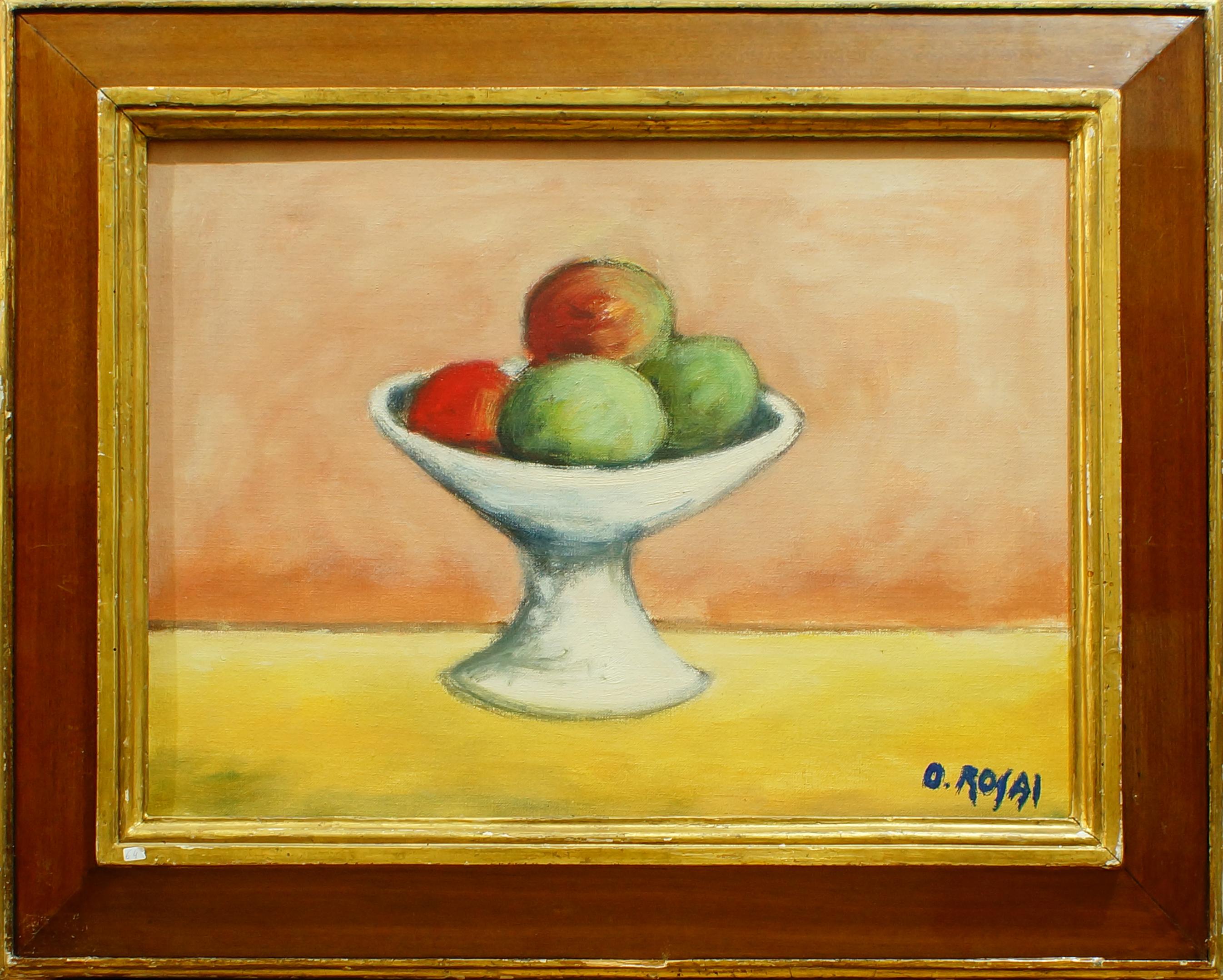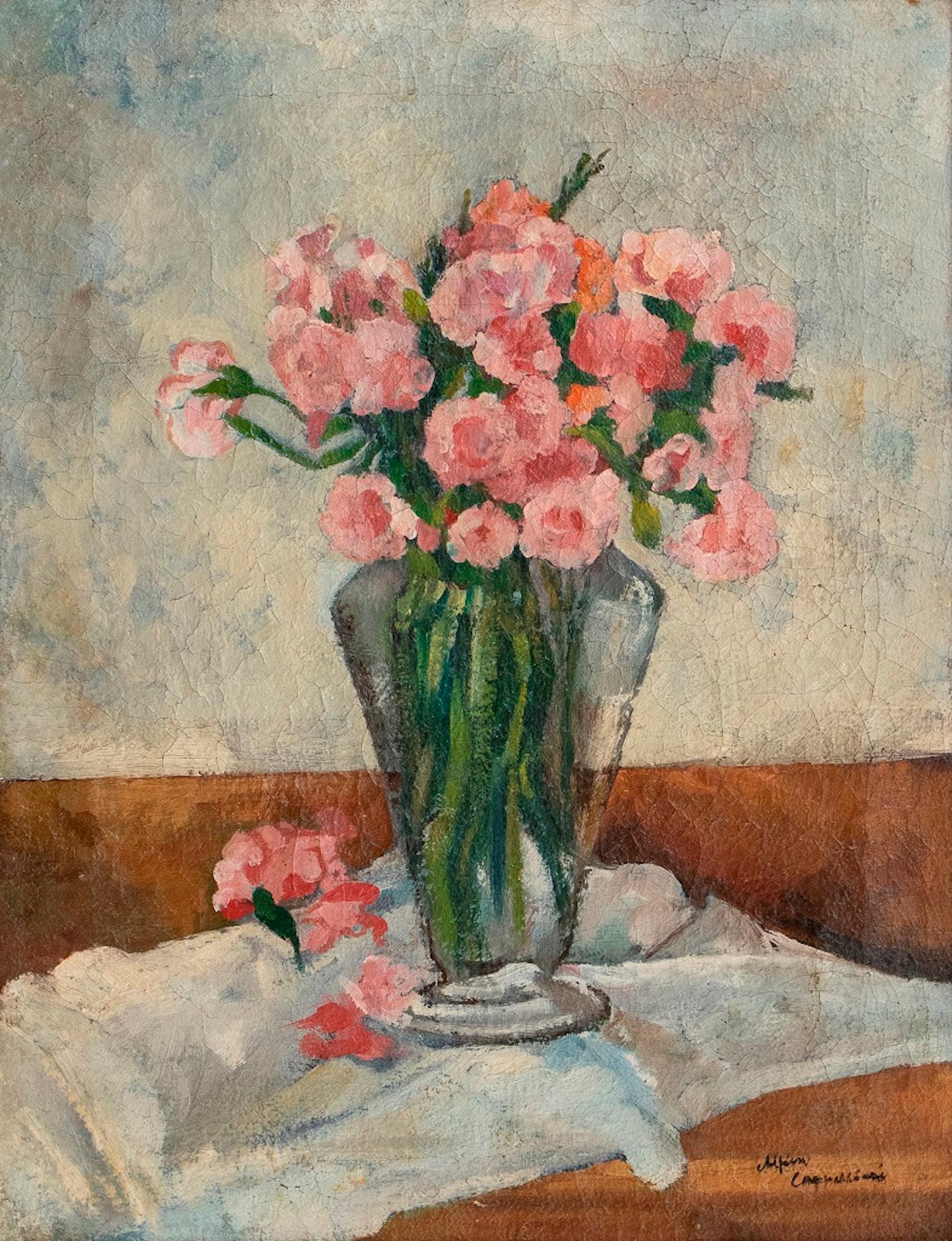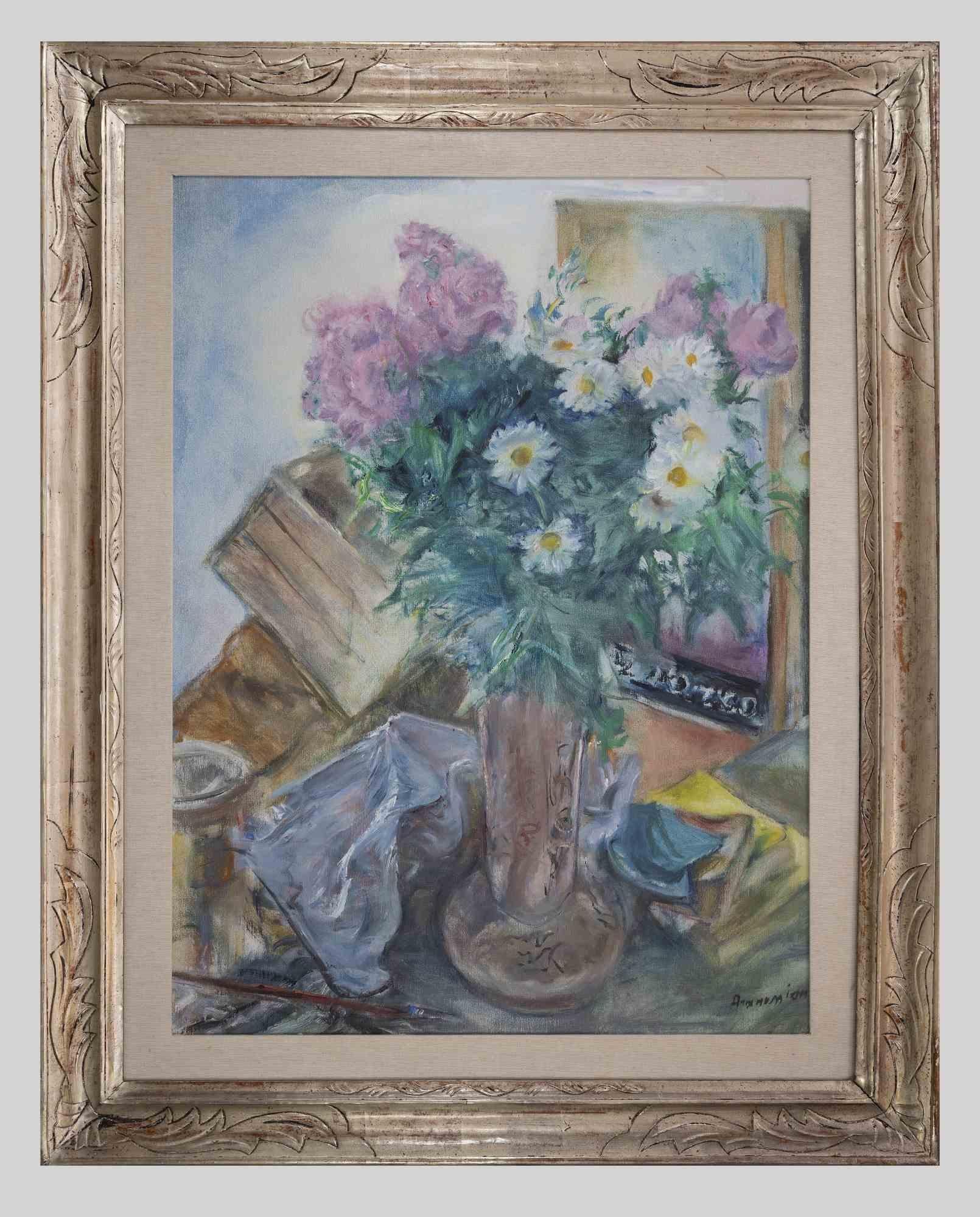Items Similar to Dutch Bamboccianti Jacob van Huchtenburg Rome Market 1674 Oil canvas
Want more images or videos?
Request additional images or videos from the seller
1 of 9
Jacob Van HuchtenbergDutch Bamboccianti Jacob van Huchtenburg Rome Market 1674 Oil canvas1674 ca
1674 ca
About the Item
The Market in Piazza del Popolo is a work by the Flemish painter Jacob van Huchtenburg, born in Haarlem and present, in the early 1660s, in Rome, in close contact with his compatriot artists who had chosen the everyday setting genre, mostly, in the city streets, the so called “bambocciata” as the theme of their paintings.
Jacob van Huchtenburg is a well-known artist, notable today for his various views of Rome with figures and he is clearly distinguishable from his younger brother Jan (Haarlem 1647-Amsterdam 1733), who paints-with a very different style-mostly battle scenes and resting horsemen, following his master Adam Frans van der Meulen.
Jacob, born in Haarlem between 1640 and 1645 (most likely in 1644), had a very brief period of artistic activity: his known works are all dated between 1670 and 1675. Very little biographical information is available for him. While the 18th century Flemish biographer Arnold Houbraken, in his notes on Dutch painters, notes Adam Frans van der Meulen as Jan van Huchtenburgh’s teacher, of Jacob (or Jakob) he speaks instead as a student of Nicholas Berchem. Between 1662 and 1667 Jacob was in Rome and between 1667 and 1669 in Paris. In 1669 he was documented in Haarlem, where he was registered in the Guild of Painters.4 He died in Amsterdam on the 8th of January, 1675.5 All the dated paintings known today were painted in Holland, probably on the basis of sketches executed in Rome.
The painting examined here represents a Market scene in Piazza del Popolo and is dated to the early 1670s, maybe 1674 like the work at the Kassel museum, similar from the point of view of style and dimensions. The unique view of the square is taken from the ancient Via Paolina, now called Via del Babuino, and on the right we can see the long ring wall and one of the two entrance gates to the Garden of the Augustinians of Santa Maria del Popolo which spread over the slopes of the Pincian hill. The square is depicted as it was before its current design, that of Giuseppe Valadier realized between the end of the 18th and the first years of the following century. In the background is the Porta Flaminia, later called Porta del Popolo, the entrance to Rome from the via Flaminia. On the top is the “fastigio chigiano” (Chigi pediment) commemorating the works commissioned by Pope Alexander VII Chigi (1655-1667) from Gian Lorenzo Bernini on the occasion and in honor of the arrival in Rome of the abdicating queen, Christina of Sweden (Stockholm 1626-Rome 1689), daughter of Gustavo Adolfo, on the 23rd of December 1655. At the center of the square is the obelisk of Seti I, erected by Domenico Fontana in 1589 at the will of Sisto V (1585-1590) and, nearby, on the left, the fountain, designed by Giacomo della Porta, which Pope Gregory XIII (1572-1585) placed in the middle of the square, prior to the placement of the obelisk, which now is found in Nicosia Square.
On the left, at the top, one can glimpse the silhouette, quite simplified, of a villa, probably from the 16th century, drafted by Raphael, Villa Madama, situated on the slopes of Monte Mario. The entire foreground of the painting is occupied by the large figures of merchants intent on selling their products, the figures of friars and beggars, these latter asking for charity, of children playing and of animals, cows and calves, brought there to be sold. The building on the left and the fountain nearby are a product of the artist’s invention: they open the scene on the left and create an equilibrium with the right side of the composition closed in by the ring wall of the garden of the Augustinian monks. Jacob van Huchtenburgh employed the same expedient, the use, for the fifth time, of the building with a fountain nearby on the left of the composition, also in the market in Piazza Colonna of the Kassel museum of 1674. As such, at the center of the square we find the Colonna Antonina which in the Piazza del Popolo is substituted by the obelisk which is the center of the square and, at the same time, the center of the painted scene.
A direct reference point for the scenes painted in the 1670s by Jacob van Huchtenburgh is the most well-known piece of Johannes Lingelbach (Frankfurt 1622-Amsterdam 1674), naturalized Dutch of German origin, who, in Rome during the second half of the 1640s, often painted, in the course of his activity, market scenes set in the most celebrated square of Rome, Piazza del Popolo which hosted beggars and visitors from the north and center of Italy arriving on the via Flaminia. One of the most famous versions of Lingelbach is the Piazza del Popolo signed and dated 1664 housed at the Academy of Vienna.11
The painting of Jacob van Huchtenburgh with the Market in the Piazza del Popolo has been relined.
Expertise by doctor Laura Laureati
- Creator:Jacob Van Huchtenberg (1640 - 1675)
- Creation Year:1674 ca
- Dimensions:Height: 41.73 in (106 cm)Width: 47.52 in (120.71 cm)
- Medium:
- Period:1670-1679
- Condition:
- Gallery Location:Florence, IT
- Reference Number:1stDibs: LU1240210334482
About the Seller
5.0
Vetted Seller
These experienced sellers undergo a comprehensive evaluation by our team of in-house experts.
Established in 1958
1stDibs seller since 2019
23 sales on 1stDibs
Typical response time: <1 hour
- ShippingRetrieving quote...Ships From: Florence, Italy
- Return PolicyA return for this item may be initiated within 2 days of delivery.
More From This SellerView All
- Signed Giovanni Colacicchi Landscape painting dated 1943 oil woodBy Giovanni ColacicchiLocated in Florence, ITThe painting is signed on the bottom left Colacicchi 43 The origins of Giovanni Colacicchi are tied to a rather important family: his grandmother Germana was a descendant of Caetani...Category
1940s Other Art Style Landscape Paintings
MaterialsOil, Wood Panel
- Signed M. Maccari Post Impressionist Figurative Painting dated 1956 oil canvasBy Mino MaccariLocated in Florence, ITThe painting (oil on canvas, 44.5 x 35 cm; with wood frame 64 x 54,5 cm) represents a moment on deception. It's signed Maccari on the bottom left, and it's dated 1956 and titled "ins...Category
1950s Post-Impressionist Figurative Paintings
MaterialsOil, Canvas
- Tuscan Figurative Genre Scene painting 20th century oil on canvasLocated in Florence, ITThe artist of this painting is unknown but it can be ascribe to a Tuscan movement of the 20th century inspired by 19th century art like Verismo (as we can deduce by the clean and not...Category
20th Century Folk Art Figurative Paintings
MaterialsCanvas, Oil
- Tuscan Figurative Genre Scene painting 20th century oil on canvasLocated in Florence, ITThe artist of this painting is unknown but it can be ascribe to a Tuscan movement of the 20th century inspired by 19th century art like Verismo (as we can deduce by the clean and not...Category
20th Century Folk Art Figurative Paintings
MaterialsCanvas, Oil
- Tuscan Historical Figurative painting 20th century oil on canvasLocated in Florence, ITThe artist of this painting is unknown, but it is a direct derivation of "The Stagecoach of the Grand Duke" by Raffaello Sorbi, now held in a private collection in Milan, as we can s...Category
20th Century Folk Art Figurative Paintings
MaterialsCanvas, Oil
- G Negri called Il Boccia Baroque Figurative Painting 17th century oil canvasBy Girolamo Negri called Il BocciaLocated in Florence, ITOil on canvas, 62 x 51 cm (without the frame) Even if on the background there is an attribution to “Francesco Gessi pupil of Guido Reni” by the bolognese art historian Guido Zucchini (dated 1945), recent studies are tending to add it to the corpus of Girolamo Negri called Il Boccia (Bologna 1648-1718) due to lots of similarities with his style (the pale and warm palette chosen, the profile) The painting represents a lady on profile wearing a brown turban, a yellow clock...Category
Late 17th Century Baroque Figurative Paintings
MaterialsCanvas, Oil
You May Also Like
- Still Life - Oil on Canvas by F. Girosi - 1927By Franco GirosiLocated in Roma, ITStill Life is a modern artwork realized by the Italian artist Franco Girosi in 1927. Oil on canvas. Hand-signed and dated on the lower left corner: Franco Girosi 1927. A wood fram...Category
1920s Modern Figurative Paintings
MaterialsCotton Canvas, Oil
- Still Life with Fruits - Oil on Canvas by Ottone Rosai - 1950 ca.By Ottone RosaiLocated in Roma, ITStill Life Painting realized by Ottone Rosai in 1950 ca. Oil on Canvas, very good conditions includes its coeval wooden frame. On rear: Label "Raccolta Giraldi Livorno-Firenze". Auth...Category
1950s Still-life Paintings
MaterialsCanvas, Oil
- Vase with Flowers - Oil on Canvas by A. Cappellini - Mid 1900By Alfiero CappelliniLocated in Roma, ITVase with Flowers is an original modern artwork realized by Alfiero Cappellini in the first half of the XX Century. Original oil on canvas. Hand-signed by the artist on the lower r...Category
Mid-20th Century Modern Figurative Paintings
MaterialsCanvas, Oil
- Still Life with Flowers and Objects - Oil on Canvas by Alfonso Avanessian - 1990Located in Roma, ITStill Life with Flowers and Objects is an original oil on canvas painting realized by Alfonso Avanessian in 1990. The piece is hand signed lower right. Hand signed, dated, and locat...Category
1990s Modern Figurative Paintings
MaterialsCanvas, Oil
- Still life with fruits on a shelf Oil painting on canvas Paolo PaolettiLocated in Milan, ITPaolo Paoletti (Padua, 1671 - Udine, 1735) Still life with fruits on a shelf Oil on canvas, 53.5 x 81 cm Expert opinion Dr. Gianluca Bocchi The still life under consideration can...Category
18th Century Figurative Paintings
MaterialsCanvas, Paint, Oil
- Witch. 2009, oil on canvas, 130x130 cmLocated in Riga, LVWitch 2009, oil on canvas, 130x130 cm Kristīne Luīze Avotiņa is a young and bright personality whose talent is appreciated not only in Latvia, but also in other parts of the world. Her deep inner experiences and feelings of the soul are not hidden from the eyes of the audience, but are openly and engagingly narrated: about relationships, man and woman, passion, emotions, about experience and connection with nature. Characters live in Kristine's compositional solutions, where figurative painting and ornament appear. When painting large-format works, she masters the entire format, composition and color of the work, as well as linear drawing. Kristīne herself emphasizes: "Relationships between nature and people - it has always been a relevant topic in my painting. The more I work on it, the more interesting it seems to me. It is infinite and unending. With paint I refresh the beauty of nature and love on the canvas and I want to show that nature and love are equal in their beauty. In my works, I always want to show that nature is beautiful and worthy of admiration - a newly blooming water lily, falling leaves from golden trees, a pink sunset sky... This could go on forever..." Education: 2009 – 2010 Studies in „Escola Massana”, Painting Department, Barcelona, Spain 2003 - 2009 Studies in Painting Department, Latvian Academy of Arts, Riga, Latvia 2003 – „Jaņa Rozentāla Riga Art College”, graduation work in photo design. 1999 - 2003 „Jaņa Rozentāla Riga Art College”, Riga, Latvia 1990 - 1999 „Riga French Lycee”, Riga, Latvia Solo exhibitions: 2010 – „1000 and 1 night” Barcelona painting...Category
Early 2000s Modern Figurative Paintings
MaterialsCanvas, Oil




